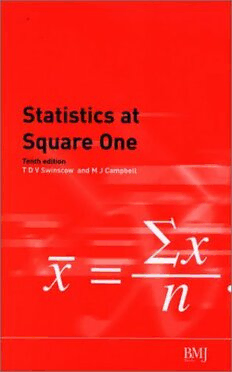
Statistics at Square One PDF
Preview Statistics at Square One
Statistics at Square One 2003.4.6 huangzhiman For www.dnathink.org To my father Statistics at Square One Tenth edition T D V Swinscow and M J Campbell Professor of Medical Statistics, Institute of General Practice and Primary Care, School of Health and Related Research, University of Sheffield, Northern General Hospital, Sheffield © BMJ Books 2002 BMJ Books is an imprint of the BMJ Publishing Group All rights reserved. No part of this publication may be reproduced, stored in a retrieval system, or transmitted, in any form or by any means, electronic, mechanical, photocopying, recording and/or otherwise, without the prior written permission of the publishers. First edition 1976 Second edition 1977 Third edition 1978 Fourth edition 1978 Fifth edition 1979 Sixth edition 1980 Seventh edition 1980 Eighth edition 1983 Ninth edition 1996 Second impression 1997 Third impression 1998 Fourth impression 1999 Tenth edition 2002 by BMJ Books, BMA House, Tavistock Square, London WC1H 9JR www.bmjbooks.com British Library Cataloguing in Publication Data A catalogue record for this book is available from the British Library ISBN 0 7279 1552 5 Typeset by SIVA Math Setters, Chennai, India Printed and bound in Spain by GraphyCems, Navarra Contents Preface vii 1 Data display and summary 1 2 Summary statistics for quantitative and binary data 12 3 Populations and samples 29 4 Statements of probability and confidence intervals 39 5 Differences between means: type I and type II errors and power 44 6 Confidence intervals for summary statistics of binary data 52 7 The t tests 62 8 The χ2 tests 78 9 Exact probability test 95 10 Rank score tests 102 11 Correlation and regression 111 12 Survival analysis 126 13 Study design and choosing a statistical test 135 Answers to exercises 145 Appendix 147 Index 153 v Preface There are three main upgrades to this 10th edition. The first is to acknowledge that almost everyone now has access to a personal computer and to the World Wide Web, so the instructions for data analysis with a pocket calculator have been removed. Details of calculations remain for readers to replicate, since otherwise statistical analysis becomes too ‘black box’. References are made to computer packages. Some of the analyses are now available on standard spreadsheet packages such as Microsoft Excel, and there are extensions to such packages for more sophisticated analyses. Also, there is now extensive free software on the Web for doing most of the calculations described here. For a list of software and other useful statistical information on the Web, one can try http:// www.execpc.com/~helberg/statistics.html or http://members.aol. com/johnp71/javastat.html. For a free general statistical package, I would suggest the Center for Disease Control program EPI-INFO at http://www.cdc.gov/epo/epi/epiinfo.htm. A useful glossary of statistical terms has been given through the STEPS project at http://www.stats.gla.ac.uk/steps/glossary/index.html. For simple online calculations such as chi-squared tests or Fisher’s exact test one could try SISA from http://home.clara.net/sisa/. Sample size calculations are available at http://www.stat.uiowa.edu/~rlenth/ Power/index.html. For calculating confidence intervals I recommend a commercial package, the BMJ’s own CIA, details of which are available from http://www.medschool.soton.ac.uk/cia/. Of course, free software comes with no guarantee of accuracy, and for serious analysis one should use a commercial package such as SPSS, SAS, STATA, Minitab or StatsDirect. The availability of software means that we are no longer restricted to tables to look up P values. I have retained the tables vii PREFACE in this edition, because they are still useful, but the book now promotes exact statements of probability, such as P=0·031, rather than 0·01<P<0·05. These are easily obtainable from many packages such as Microsoft Excel. The second upgrade is that I have considerably expanded the section on the description of binary data. Thus the book now deals with relative risk, odds ratios, number needed to treat/harm and other aspects of binary data that have arisen through evidence-based medicine. I now feel that much elementary medical statistics is best taught through the use of binary data, which features prominently in the medical literature. The third upgrade is to add a section on reading and reporting statistics in the medical literature. Many readers will not have to perform a statistical calculation, but all will have to read and interpret statistical results in the medical literature. Despite efforts by statistical referees, presentation of statistical information in the medical literature is poor, and I thought it would be useful to have some tips readily available. The book now has a companion, Statistics at Square Two, and reference is made to that book for the more advanced topics. I have updated the references and taken the opportunity to correct a few typos and obscurities. I thank readers for alerting me to these, particularly Mr A F Dinah. Any remaining errors are my own. M J Campbell http://www.shef.ac.uk/personal/m/michaelcampbell/index.html viii 1Data display and summary Types of data The first step, before any calculations or plotting of data, is to decide what type of data one is dealing with. There are a number of typologies, but one that has proven useful is given in Table 1.1. The basic distinction is between quantitative variables (for which one asks “how much?”) and categorical variables (for which one asks “what type?”). Quantitative variables can be either measured orcounted. Measured variables, such as height, can in theory take any value within a given range and are termed continuous. However, even continuous variables can only be measured to a certain degree of accuracy. Thus age is Table 1.1 Examples of types of data. Quantitative Measured Counted Blood pressure, height, Number of children in a family weight, age Number of attacks of asthma per week Number of cases of AIDS in a city Categorical Ordinal Nominal (Ordered categories) (Unordered categories) Grade of breast cancer Sex (male/female) Better, same, worse Alive or dead Disagree, neutral, agree Blood group O, A, B, AB 1
